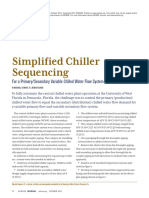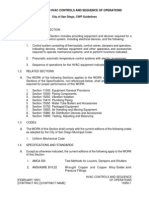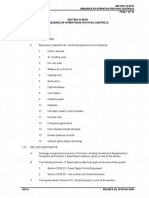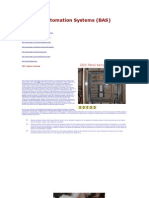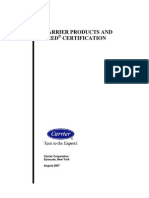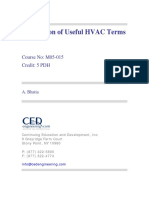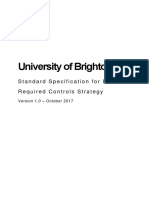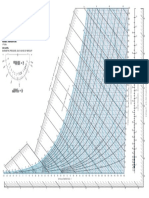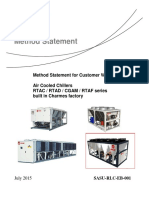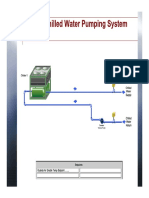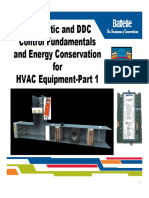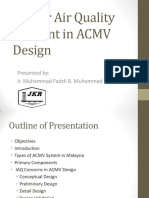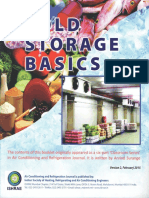HVAC Sequence of Operations
Uploaded by
Bruno CannasHVAC Sequence of Operations
Uploaded by
Bruno CannasHVAC Systems at Y2E2
Y2E2 HVAC sequence of operation
(controls)
Week 3
CEE 243
Copyright 2012
HVAC Systems at Y2E2
Big idea
Modern energy management systems include a
combination of passive and active control of energy
distribution
Passive: constant (volume/flow)
Active: variable (volume/flow) under computer
control
Based on If-then conditional control rules of
general form
If setpoint value out of range and
Other conditions met
Then adjust control variable value
CEE 243
2
Copyright 2012
HVAC Systems at Y2E2
Jargon
Active beam
AHU
CAV
Cfm
Condition
Diffuser
Diff pressure
Fabric loss
Fan coil
Heat exchanger
JK-1
Natural ventilation
Radiant slab
Setpoint
Tempered hot/cold
water
U value
VAV
Zone
Zone splitter
CEE 243
3
Copyright 2012
HVAC Systems at Y2E2
Control basics
Typically active response components have a setpoint,
i.e., operating functional objective value
E.g., room temperature setpoint = 73 +- 3oF
Under computer control, the HVAC building management
system (BMS) adjusts value of active control components
to maintain the setpoint of response components
e.g., flow rate damper position = 0 100% open
BMS rules tell control system how to reach setpoint
BMS is linked to input sensors and output control signals
CEE 243
4
Copyright 2012
HVAC Systems at Y2E2
Active beams provide efficient conditioned
fresh air to spaces: mostly passive
(Chilled) water passes through "beam"
heat exchanger
beam chills air
air becomes denser
(cool) air falls to floor
Convection & room cooling
Heating similar
Reason for efficiency: heat capacity of
water >> that of air: 1 cubic foot
Air: heat capacity 37 JK-1
Water: heat capacity 20,050 JK-1.
heat/cool with much lower pumped
volume in smaller components
CEE 243
5
Copyright 2012
HVAC Systems at Y2E2
Simple control example Active beam
constant
Heat if SP < 71 F
Cool if SP > 75 F
Deadband +/- 2 F
CEE 243
6
Copyright 2012
HVAC Systems at Y2E2
(Direct)
Response
variable
Deadband control
1000
120
900
100
700
Air flow CFM
80
600
500
400
60
Deadband
40
300
Valve Position percent
800
Control
variable
Air Flow
Cooling Valve
Heating Valve
200
20
100
0
0
65 66 67 68 69 70 71 72 73 74 75 76 77 78 79 80 81 82 83 84 85
Temperature degrees F
CEE 243
Setpoint
7
Copyright 2012
HVAC Systems at Y2E2
Active beams
Active (control) components: Cold and hot water valves, air
flow damper
Temperature control examples:
Occupied room air temperature setpoint user adjustable +/- 3F
Unoccupied setpoints: cooling =78F; heating = 65F
Control cold and/or hot water active beam valve position to
achieve room air temperature setpoint
Temperature control deadband of +/- 2F
User override can extend occupied hours by 2 hours
Active beam air flow control:
Air flow rate constant on during occupied hours (basement 24/7);
off during unoccupied hours
CAV boxes modulate flow to achieve constant air flow during
occupied hours only, except during night setback and warmup
(compensating for different air pressures)
CEE 243
8
Copyright 2012
HVAC Systems at Y2E2
North facing spaces contain radiators to
balance fabric heat losses
Fabric heat loss through materials w/ temperature
difference, e.g., walls, windows, floor, roof.
Heat loss Q = U * Area * Delta-temperature
CEE 243
9
Copyright 2012
HVAC Systems at Y2E2
Baseboard radiators
Active components: hot water control valve
Temperature control examples:
Occupied temperature setpoint adjustable by
user +/- 3F
Unoccupied heating temperature setpoint: 65F
Control hot water valve position of baseboard
heater to achieve room air temperature setpoint
If outside air temperature > 78F close valve
at all times
User override extends occupied hours 2 hours
CEE 243
10
Copyright 2012
HVAC Systems at Y2E2
Conference rooms
Active beam control as in other rooms
Active component: inline supply fan
Additional CO2 level control
If CO2 concentration > max CO2 setpoint
open inline supply fan
Max CO2 setpoint = 500 ppm above outside
air CO2 concentration
CEE 243
11
Copyright 2012
HVAC Systems at Y2E2
Laboratories
Active components: damper, water coil valves
Air flow control
The greater of:
The required air changes (6 air changes/hr)
Amount needed for cooling
Sufficient makeup air for fume hoods (supply ~ exhaust)
For heating air flow is set to minimum
For cooling air flow is set to maximum
Temperature control
+/- 2F deadband
CEE 243
12
Copyright 2012
HVAC Systems at Y2E2
Radiant floor
CEE 243
13
Copyright 2012
HVAC Systems at Y2E2
Radiant floor
Active components: Pump and valve
Pump off if outside air temperature > 78F
Otherwise
Turn on pump
To reach steady state:
Increase valve position by 10% (every 10 min) until
temperature setpoint of 71F is met
Decrease valve position by 5% (every 10 min) until
temperature setpoint of 71F is met
After reaching steady state
Adjust valve position by 1% (every 10 min) only
During unoccupied hours temperature setpoint = 66F
CEE 243
14
Copyright 2012
HVAC Systems at Y2E2
Fan Coil Units
CEE 243
15
Copyright 2012
HVAC Systems at Y2E2
Fan coil units
Active components: chilled water control
valve
On 24/7
Temperature control:
Modulate chilled water valve position to
achieve temperature setpoint if space
temperature is above setpoint
If two spaces are controlled by one unit,
control using higher space temperature
CEE 243
16
Copyright 2012
HVAC Systems at Y2E2
Main chilled water loop
Serves:
Tempered water loop
Cooling coils
(AHU, FC, CVs, VAVs)
Server Rack
CEE 243
17
Copyright 2012
HVAC Systems at Y2E2
Chilled water system
Active components: Control valve and
booster pump
Normal operation: Valve is used to control
differential pressure to setpoint (if not
enough booster pump helps out)
If water return temp < 58F (for > 5 min) reset
down differential pressure setpoint
If water return temp < 55F (for > 5 min), start
pump and recirculate water
If water supply temp < 48F go back to normal
CEE 243
18
Copyright 2012
HVAC Systems at Y2E2
Tempered chilled water
loop
Serves:
Active beams
CEE 243
19
Copyright 2012
HVAC Systems at Y2E2
Tempered chilled water system
Active components: Two pumps
On/off speed control
Lead/lag operation (weekly)
Pumps are controlled to meet differential pressure setpoint
lead pumps first
If pressure difference too small, lag pump starts in addition
If both run slow (< 25Hz), turn off lag pump
Pumps should be off during unoccupied hours (expect overrides)
Temperature control
Maintain supply water temperature at 60F by opening and
closing control valve
Supply Temp Reset (to prevent condensation on active beams)
If outside dewpoint temperature > 58F
-> supply temperature setpoint = dewpoint temperature + 2F
CEE 243
20
Copyright 2012
HVAC Systems at Y2E2
Main hot water loop
CEE 243
Serves:
Tempered water loop
Heating coils
(AHU, CVs)
Radiators
21
Copyright 2012
HVAC Systems at Y2E2
Hot water system
Active components: Two pumps, heat
exchanger valve
On/Off speed control
Same as for tempered chilled water system
If no hot water is needed close heat exchanger
valve
Temperature control
Maintain supply water temperature at 180F by
opening and closing value 1 (1/3 of flow) and
valve 2 (2/3 of flow)
CEE 243
22
Copyright 2012
HVAC Systems at Y2E2
Main hot water loop
CEE 243
Serves:
Tempered water loop
Heating coils
(AHU, CVs)
Radiators
23
Copyright 2012
HVAC Systems at Y2E2
Tempered hot water system
Active components: Two pumps, valve
On/Off speed control
Same as for hot water system
Temperature control
Maintain supply water temperature at 110F
by opening and closing value
CEE 243
24
Copyright 2012
HVAC Systems at Y2E2
Air handling unit
CEE 243
25
Copyright 2012
HVAC Systems at Y2E2
Air handling unit
Sequence of Operations - Cooling
if 1. Cooling coil valve position (219) > 0
And 2. if the outside air temperature (1123) >
exhaust air temperature (1128),
then 3. heat pipe bypass damper (221) will modulate
closed forcing air to pass over the heat pipe &
CEE 243
avoid
precooling.
26
Copyright 2012
HVAC Systems at Y2E2
Air Handling Units (1)
Active components: fans, heating and
cooling coil water valve, heat recovery
bypass valve, cooling coil bypass valve
24/7 because of labs in the basement
Maintain static pressure setpoint by
modulating fan speed
Supply air to be maintained at 65F (max
DewPoint 60F)
Cooling, Heating, Dehumidification, Morning
Warm-up
CEE 243
27
Copyright 2012
HVAC Systems at Y2E2
Air Handling Units (2) - cooling
Active components: heat recovery bypass damper, cooling coil
bypass damper, cooling coil valve
Heat recovery
If outside air temperature > exhaust air temperture -> heat
recovery bypass damper closed (heat recovery on) otherwise
open
Heat recovery bypass damper modulates to set supply air
temperature to setpoint
Cooling
If no heating and supply air temperature > setpoint
-> cooling coil bypass damper closed and cooling coil valve
modulates to achieve setpoint
If no heating and supply air temperature < setpoint
-> first close valve then close bypass damper
CEE 243
28
Copyright 2012
HVAC Systems at Y2E2
Air Handling Units (3) - heating
Active components: heat recovery bypass damper, cooling coil
bypass damper, cooling coil valve
Heat recovery
If outside air temperature < heat recovery leaving temperature
& exhaust air temperature > heat recovery leaving temperature
-> heat recovery bypass damper closed (heat recovery on)
otherwise open
Heat recovery bypass damper modulates to set supply air
temperature to setpoint
Heating
If no cooling and supply air temperature < setpoint
-> heating coil bypass damper closed and heating coil valve
modulates to achieve setpoint
If no cooling and supply air temperature > setpoint
-> first close valve then close bypass damper
CEE 243
29
Copyright 2012
HVAC Systems at Y2E2
Air Handling Units (4) - dehumidification
If leaving air dewpoint temperature > 60 F
then maintain dewpoint setpoint in
addition to temperature setpoint with
additional heating to lower moisture
content in air
CEE 243
30
Copyright 2012
HVAC Systems at Y2E2
Air Handling Units (5) Morning
warmup
Only if daytime temperature does not
exceed 68F
2-6 am air supply temperature setpoint is set
to 69F
After 6am everything is set to normal
CEE 243
31
Copyright 2012
HVAC Systems at Y2E2
Air handling unit
Apply the rule to lots of data
'M2_AHU M2_AHU 'M2_AHU ,
'M2_AHU
M2_AHU 1_HeatRe 1_HeatRe 1_Exhaus 'M2_AHU 1_HeatRe
1_Outsid cExhaust cExhaust tAirFlow 1_CoolCo cBypassD
eAirTem ExitTemp Temp_ Rate_
ilValvePo amperPo
('DateTime',
p_1123', _1105', 1128',
1127'
s_ 219', s_ 221') OAT>EAT
3/27/2009 11:25
22
22
22
9
47.6
0
3/27/2009 11:30
22
22
22
9
48
0
3/27/2009 11:35
22
22
22
9
48
0
3/27/2009 11:40
22
22
22
9
49
0
3/27/2009 11:45
23
22
22
9
49
0
3/27/2009 11:50
23
22
22
9
49
0
3/27/2009 11:55
23
22
22
9
49.8
0
3/27/2009 12:00
23
22
22
9
50
0
3/27/2009 12:05
23
22
22
9
50
0
3/27/2009 12:10
23
22
22
9
51
0
3/27/2009 12:15
23
22
22
9
51
0
Sequence of Operations - Cooling
if 1. Cooling coil valve position (219) > 0
And 2. if the outside air temperature (1123) >
exhaust air temperature (1128),
then 3. heat pipe bypass damper (221) will modulate
closed forcing air to pass over the heat pipe &
CEE 243
avoid
precooling.
Cooling
if 1. Cool
HP
And 2. if
Intended
HP
damper
then 3. h
HP bypass damper position
the heat
damper
position
closed
closed
closed
closed
closed
closed
closed
closed
closed
closed
closed
position
OK?
OK
OK
OK
OK
OK
OK
OK
OK
OK
OK
OK
always
OK?
Ok
32
Copyright 2012
HVAC Systems at Y2E2
Air handling unit
Apply the rule to lots of data
'M2_AHU M2_AHU 'M2_AHU ,
'M2_AHU
Intended
HP
M2_AHU 1_HeatRe 1_HeatRe 1_Exhaus 'M2_AHU 1_HeatRe
HP
HP
damper
1_Outsid cExhaust cExhaust tAirFlow 1_CoolCo cBypassD
bypass damper position
eAirTem ExitTemp Temp_ Rate_
ilValvePo amperPo
damper position always
('DateTime',
p_1123', _1105', 1128',
1127'
s_ 219', s_ 221') OAT>EAT position
OK?
OK?
3/27/2009 12:20
23
22
22
9
52
40
closed
bad
problem
3/27/2009 12:30
23
22
22
9
53
20
closed
bad
3/27/2009 12:35
24
23
22
9
53.2
40
closed
bad
3/27/2009 12:40
23
22
22
9
54
40
closed
bad
3/27/2009 12:45
24
23
22
9
54
60
closed
bad
3/27/2009 12:50
23
22
22
9
54
40
closed
bad
3/27/2009 12:55
24
23
22
9
54
40
closed
bad
3/27/2009 13:00
24
23
22
9
54
80
closed
bad
3/27/2009 13:05
24
23
22
9
54.6
99.8
closed
bad
3/27/2009 13:10
24
23
22
9
54
100
closed
bad
3/27/2009 13:15
24
23
22
9
54
49.75
closed
bad
Sequence of Operations - Cooling
if 1. Cooling coil valve position (219) > 0
And 2. if the outside air temperature (1123) >
exhaust air temperature (1128),
then 3. heat pipe bypass damper (221) will modulate
closed forcing air to pass over the heat pipe &
CEE 243
avoid
precooling.
Cooling
if 1. Cooling coi
And 2. if the ou
then 3. heat pip
the heat pipe &
33
Copyright 2012
HVAC Systems at Y2E2
Mechanical ventilation
CEE 243
34
Copyright 2012
HVAC Systems at Y2E2
Building pressurization control
Basement:
Labs: Negative pressure: 5-10% more
exhaust air than supply
Offices: Positive pressure: 5-10% more
supply air than exhaust
Above Grade levels:
If static pressure rises above 0.03 w.c. atria
dampers open to keep pressure below 0.03
CEE 243
35
Copyright 2012
HVAC Systems at Y2E2
Natural ventilation
CEE 243
36
Copyright 2012
HVAC Systems at Y2E2
Natural ventilation
Active components: Operable windows, atria damper
Initial range for natural ventilation outside air temperature 68 85F
If outdoor temperature is within range & average space
temperature > 70F -> open dampers
For each zone where temperature > 70F open operable
windows
If zone temperature < 70F for at least 5 min close windows
If all windows around one atrium are closed close
corresponding atrium damper
Night purge (if daytime outside air temperature exceeds 75F)
During unoccupied hours open windows if Outside air
temperature < 65F and space temperature > 65F Close
windows if space temperature < 63F
CEE 243
37
Copyright 2012
HVAC Systems at Y2E2
Representative offices in Y2E2
2 offices on the North side with radiant
heating and ceiling fans
CEE 243
38
Copyright 2012
HVAC Systems at Y2E2
Representative offices in Y2E2
2 offices on the South side with active
beams (heating and cooling)
CEE 243
39
Copyright 2012
HVAC Systems at Y2E2
Workflow to interpret building energy monitoring data
Functional intent
Measured data (x 2400
points @ 1x/minute)
Work flow
Step 1
Select system & points for
analysis
All Ok
Step 2
Synthesize functional
intent and data context
All Ok
Step 3
Access and graph data
Else repeat Step 3 for additional clarity
Summary assessment
All Ok
Step 4
Assess data conformance
to functional intent
Else
All Ok
Step 5
Identify potential causes
Else
All Ok
Step 6
Steps 1-4 for
satisfactory fault
diagnosis
Document and discuss
findings
Else
CEE 243
Steps 1-3 for
additional
clarity
All Ok
End
Steps 1-5 to
Clarify
40
Copyright 2012
HVAC Systems at Y2E2
Reading
ACCO engineered systems, HVAC Sequences of
Operation for Stanford SEQ2 Environment and Energy
Building, 2007
Abram, T., J. Kunz, J. ODonnell, and M. Garr, Energy
Performance Analyses of a Santa Clara County Facility
by CEE243 Student Groups, CIFE Technical Report
#TR204, 2011
CEE 243
41
Copyright 2012
HVAC Systems at Y2E2
Homework
For an assigned system, compare
patterns between different years (2008,
2009, 2010)
Classify pattern (red/yellow/green) re
assumed functional intent
CEE 243
42
Copyright 2012
HVAC Systems at Y2E2
Big idea
Modern energy management systems include a
combination of passive and active control of energy
distribution
Passive: constant (volume/flow)
Active: variable (volume/flow) under computer
control
Based on If-then conditional control rules of
general form
If setpoint value out of range and
Other conditions met
Then adjust control variable value
CEE 243
43
Copyright 2012
You might also like
- Sequences of Operation For Common HVAC Systems100% (4)Sequences of Operation For Common HVAC Systems180 pages
- Sequence of Operations For Hvac ControlsNo ratings yetSequence of Operations For Hvac Controls4 pages
- ARTICLE Simplified Chiller Sequencing PDFNo ratings yetARTICLE Simplified Chiller Sequencing PDF6 pages
- Section 230993 - Sequence of Operations For Hvac ControlsNo ratings yetSection 230993 - Sequence of Operations For Hvac Controls2 pages
- Hvac Controls and Sequence of OperationsNo ratings yetHvac Controls and Sequence of Operations16 pages
- 0416 Section 230993 Sequence of Operations For HVAC ControlsNo ratings yet0416 Section 230993 Sequence of Operations For HVAC Controls15 pages
- RP-1455 Advanced HVAC Control Sequences For Airside EquipmentNo ratings yetRP-1455 Advanced HVAC Control Sequences For Airside Equipment105 pages
- Series Counter Flow - Sequence of Operation05-17-2011No ratings yetSeries Counter Flow - Sequence of Operation05-17-201110 pages
- Sequence of Operation For Floor Mounted AHUNo ratings yetSequence of Operation For Floor Mounted AHU1 page
- 918d Standard Building Automation System BAS Specification For City Buildings 2015No ratings yet918d Standard Building Automation System BAS Specification For City Buildings 201539 pages
- Daikin VAV With Reheat Systems AppGuide AG31-021 LRNo ratings yetDaikin VAV With Reheat Systems AppGuide AG31-021 LR36 pages
- Different Control Strategies For Chiller Plant100% (1)Different Control Strategies For Chiller Plant19 pages
- Daikin Ducted Air Conditioning Au BrochureNo ratings yetDaikin Ducted Air Conditioning Au Brochure24 pages
- Fundamentals of Psychrometrics: Second Edition100% (2)Fundamentals of Psychrometrics: Second Edition13 pages
- A DEH PR-2014-0112-GB Hydraulik-Handbuch BR R2!02!2017 150dpiNo ratings yetA DEH PR-2014-0112-GB Hydraulik-Handbuch BR R2!02!2017 150dpi84 pages
- ASHARE 36 Aee - April - 2021 - Ashrae - Guideline - 36No ratings yetASHARE 36 Aee - April - 2021 - Ashrae - Guideline - 3642 pages
- Total Cost of Ownership Chilled Water SystemsNo ratings yetTotal Cost of Ownership Chilled Water Systems46 pages
- DDC System Commissioning Acceptance Procedure: Example Project/Building DescriptionNo ratings yetDDC System Commissioning Acceptance Procedure: Example Project/Building Description3 pages
- Unica He Installation and Servicing ManualNo ratings yetUnica He Installation and Servicing Manual40 pages
- Section 230993 - Sequence of Operations For Hvac ControlsSection 230993 - Sequence of Operations For Hvac Controls
- 0416 Section 230993 Sequence of Operations For HVAC Controls0416 Section 230993 Sequence of Operations For HVAC Controls
- RP-1455 Advanced HVAC Control Sequences For Airside EquipmentRP-1455 Advanced HVAC Control Sequences For Airside Equipment
- Series Counter Flow - Sequence of Operation05-17-2011Series Counter Flow - Sequence of Operation05-17-2011
- 918d Standard Building Automation System BAS Specification For City Buildings 2015918d Standard Building Automation System BAS Specification For City Buildings 2015
- Daikin VAV With Reheat Systems AppGuide AG31-021 LRDaikin VAV With Reheat Systems AppGuide AG31-021 LR
- A DEH PR-2014-0112-GB Hydraulik-Handbuch BR R2!02!2017 150dpiA DEH PR-2014-0112-GB Hydraulik-Handbuch BR R2!02!2017 150dpi
- ASHARE 36 Aee - April - 2021 - Ashrae - Guideline - 36ASHARE 36 Aee - April - 2021 - Ashrae - Guideline - 36
- DDC System Commissioning Acceptance Procedure: Example Project/Building DescriptionDDC System Commissioning Acceptance Procedure: Example Project/Building Description




